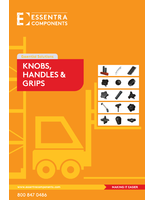Tips for Managing Class "C" Components with Vendor Managed Inventory
I recently came across this article from Scott Frahm and SCRC on Three Steps in Making Vendor Managed ASF-Parts Inventory Work. I found it particularly interesting in regard to managing class "C" components such as industrial fasteners. By paying attention to these tips, and using a good dose of common sense, you can quickly start taking advantage of the benefits of a good vendor managed inventory program. And better yet, quit spending a dollar to chase a dime.
The goal of vendor managed Inventory is to provide a mutually beneficial relationship where both sides will be able to more smoothly and accurately control the availability and flow of goods.
In VMI, a manufacturer or distributor assumes the role of inventory planning for the customer. Extensive information sharing is required so that the manufacturer/distributor can maintain a high degree of visibility of its goods at the customer's location. Instead of the customer reordering when its supply has been exhausted, the supplier is responsible for replenishing and stocking the customer at appropriate levels.
Customer Benefits
When the supplier can see that its customer is about to exhaust its inventory, the supplier can better prepare to replenish the customer because the supplier can then better schedule its own production/distribution. Customers will reduce/eliminate stockouts because they will not have to reorder goods at the last minute without knowing whether the supplier has the ability to restock without interrupting the customer's operations. Therefore, part of VMI's goal is to reduce uncertainty that arises when the supplier is blind to the customer's inventory status.
Supplier Benefits
As long as the supplier carries out its task of maintaining predetermined inventory and avoiding stockouts, it will be able to lock in a VMI-supported customer for the long term with or without a contract. This will produce a steady and predictable flow of income for the supplier and reduce the risk that the customer will switch suppliers (Switching would be too costly for the customer). A VMI arrangement will allow the supplier to schedule its operations more productively because it is now monitoring its customer's inventory on a regular basis. Furthermore, reductions in inventory will be achieved once the supplier develops a better understanding of how the customer uses its goods over the course of a year.
How to make VMI work
1. Clarify expectations. There needs to be thorough discussion about how the system will benefit both organizations in the long term or one of the parties, particularly the supplier, is prone to disappointment with some of the short-term results. If these items are not addressed the program will likely be terminated quickly with neither side gaining any of the benefits expected from the program. The objective is clear and constant communication between the supplier and customer. When the two parties work in conjunction they can be assured that the planning function, for both sides, will begin to smooth over time.
2. Agree on how to share information. If the supplier and customer can agree to share information vital to restocking in a timely manner, then the odds of a synchronized system will dramatically improve. Proprietary information would not have to be shared between the supplier and customer, but enough information to maintain a steady flow of goods is necessary. The customer should be willing to share production schedules and/or forecasts to provide some visibility for the supplier.
3. Keep communication channels open. When the two parties set out to implement a VMI program, they need to meet and discuss their goals and how they need to proceed in order to realize those goals. Once a VMI program has been activated, each side needs to understand that there are going to be some miscues. These miscues need to be studied as opportunities for learning and then used to avoid repetitive problems in the future.
Common Mistakes
Unexpected demand changes by the customer need to be shared with the supplier. Changes in demand could result from the customer acquiring a new, large customer opening of a great deal of stores in a short period; or offering special promotions that create spikes in demand. The supplier may be unable to schedule production or shipment in a timely manner, causing a drop in inventory available for the customer to sell in the event of a foreseen increase in demand. A spike in demand could also create a burden on the supplier, who will have to reprioritize its production plan or inventory from one customer to another. Likewise, if the supplier is experiencing a significant spike in demand from a major customer, it may be wise to let the VMI customer, and other customers as well, know that the supplier will have very little flexibilty over a certain period of time, so that everyone can adjust accordingly.
The most common cause of VMI failure revolves around communication breakdowns. All of these problems in implementing a VMI program can be significantly diminished if they are adequately addressed at the beginning of discussions. Hence, there should be several in-depth meetings upfront to avoid problems down the road.




